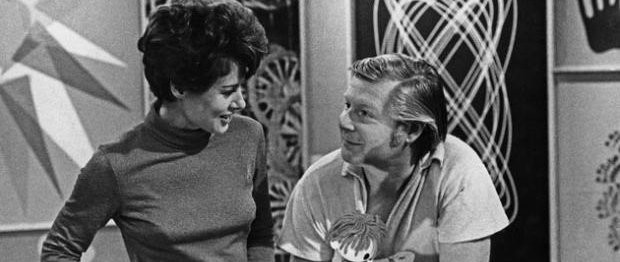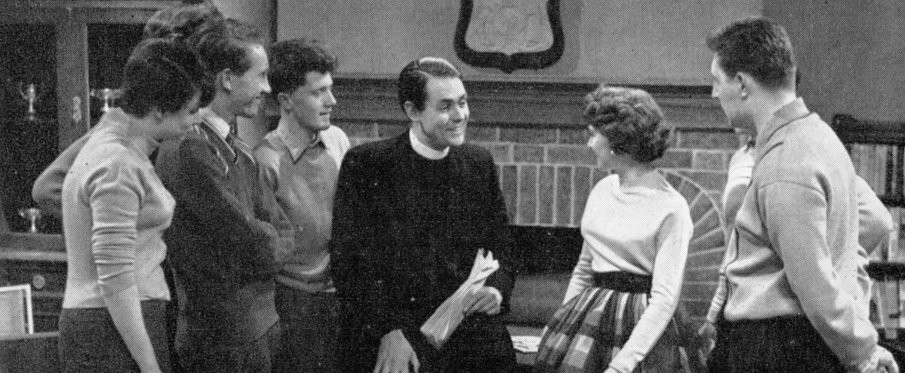
Vision On
1964 - United Kingdom"Six years of extraordinary imaginative humorous visual programming. It reached cult status, amongst a normal hearing children's and adult audience, as well as a hard-of-hearing audience, not only in this country but throughout the world. It was sold to all the syndicated stations across the USA, we had co-productions with Canada, USA, Sweden, Germany, France and Switzerland. In fact Vision On by 1977 had been sold to practically every country in the world. - Clive Doig (Director of Vision On).
In 1952 Freda Lingstrom, then head of BBC Children's Television, wanted to start a programme for deaf children and approached Ursula Eason to experiment with a format. Eason, who was born in London in 1910, had been educated privately at schools in Streatham and had taken an English degree at University College London. She was approached by the BBC via the London University appointments board, and at the age of 23 was offered the job of Children's Hour Organiser in Belfast, where she stayed somewhat unwillingly for the next 8 years. In 1962 Eason was allowed to transfer to London and to television, where she was attached to Television Talks, the Film Unit and finally Children's Programmes where Lingstrom offered her the opportunity to pioneer a new type of programme.
Hard of hearing herself, Ursula Eason set about meeting deaf children to try and find a winning format. At her first meeting she said she was struck by the children's friendliness and their quick perception. In 1953 Eason launched For Deaf Children, in co-operation with Roy Cole of the Royal National Institute for the Deaf (RNID). The programme was shown monthly. Pat Keysell made her debut with For Deaf Children by introducing mimes acted out by deaf actors. However, by the end of the 1950s deaf children began to complain that their programme was slow and different from other programmes.

Pat Keysell was undoubtedly a key figure in helping to shape the future programmes format. "Having returned to England in 1958 after living abroad for some years, my marriage over and a small boy in tow, I went to work for the BBC. Like a lot of theatre people, I was fascinated by the emerging possibilities of television, and by a stroke of good fortune I got a job as secretary to Ursula Eason, (by now promoted to) Assistant Head of Children's Programmes. At that time Ursula was producing and directing a monthly programme called For Deaf Children and so began my interest and involvement with deafness. Ursula knew I had been an actress and drama teacher, so she backed me when I suggested starting a mime group for deaf actors who could perform little plays on the programme. This came about, and The Mime Group appeared many times on For Deaf Children between 1960 and 1964. By 1964 I was a PA in television drama, but I met Ursula in the canteen and she said "I am launching a new programme called Vision On and I want you to present it!"
Vision On began in March 1964, and was at first, like its predecessor, only a monthly programme. Talking to children at the time Ursula found that the one element they felt missing from For Deaf Children was fun. "They love Western's and anything that makes them laugh - clowns, circuses, variety acts as all children do. Then illustrated stories, when they are able to lip read the spoken word. Mime and plays are also popular." For these the BBC issued detailed synopses of serials for the deaf beforehand to make it easier to follow what was happening on screen. "Also popular are racing cars, in fact they love almost anything fast-moving, and of course animals, and simple competitions." Eason insisted that signing was used as a means of communication, although this was frowned on by many teachers of the deaf. But there was great support from the RNID and the National Deaf Children's Society. Pat Keysell was very involved in the new conception. "For the first year it was just Ursula and me; in the second year one of the new directors decided I looked a bit lonely and brought in Tony Hart as a fellow presenter."

Producer Patrick Dowling said at the time, "Children's minds leap around in a not too dissimilar manner" and it was true that the format for the show strived to be as much like those made for hearing children as possible. Director Alan Russell also gave Vision On its fast paced style. As one observer noted, the show was: "Often quite surreal, with quirky animation, it was also unique in that it was designed for hearing & non-hearing children alike. The series was essentially art & performance based but would often go off on extreme tangents - much to the delight of its viewers. The bizarre mish-mash of ideas gave it a quality all of its own and is perhaps why it has become so firmly lodged in the subconscious of its viewers even after so many years."

The one area that both hearing and non-hearing children had at least some common ground in was art, painting and drawing and arty features by Tony Hart dominated the show. "In Vision On we showed them many things, man-made and natural, and linked together some of their similarities and contrasts. There was always something there to inspire. They used their eyes and their imagination did the rest." One regular feature of the show was 'The Gallery' where drawings sent in by the viewers were displayed on a wall. Patrick Dowling recalls just how successful this feature was and how much hard work went into it: "The Gallery was completely genuine but became a major job. At the peak we were getting about 10,000 entries a week! Tony went in and reduced it to a pile of fifty or so which he though had merit, then I picked the two dozen I thought could be shown on camera to advantage. Between us we tried to show at least a couple from each age from 4 to 14 roughly."
It took about two weeks to put together a 25-minute programme. Vision On, which was made at BBC Bristol, ran until 1976. Many of its contributors and viewers went on to become film makers, performers and artists in their own right - in fact nothing has surpassed Vision On for such a wealth of talent and ideas. In an age where subtitles to all programmes can be summoned by just the touch of a button - it is unlikely we will see its like again.
Seen this show? How do you rate it?
Seen this show? How do you rate it?
Published on February 11th, 2019. Written by Marc Saul (January 2011) for Television Heaven.










